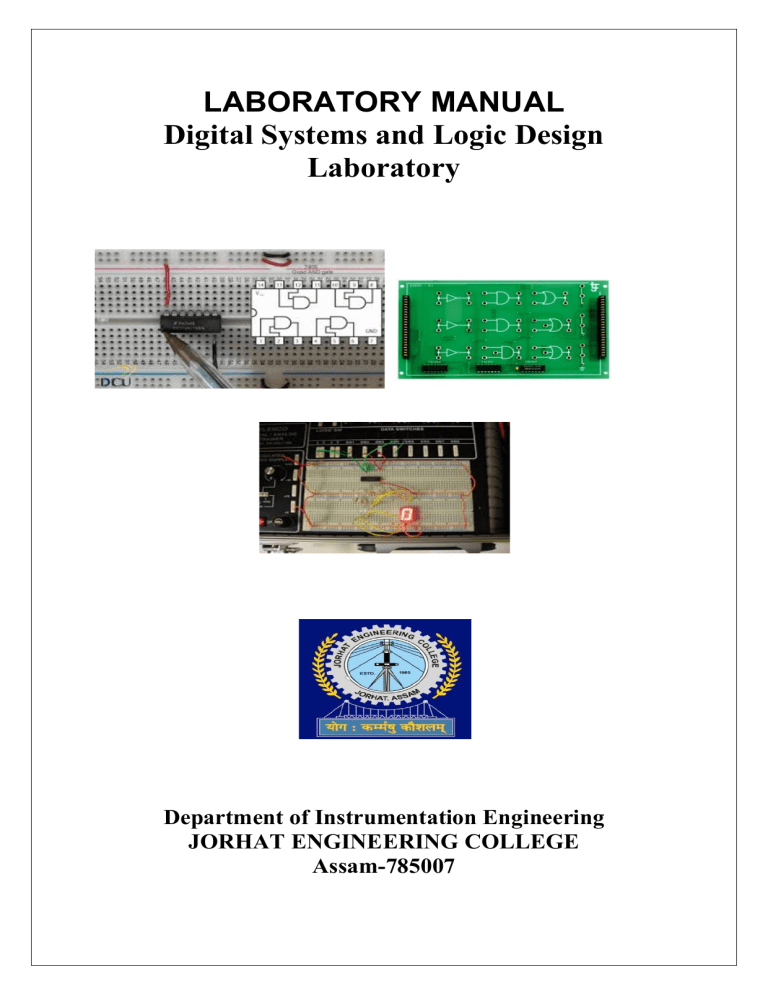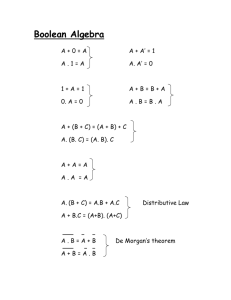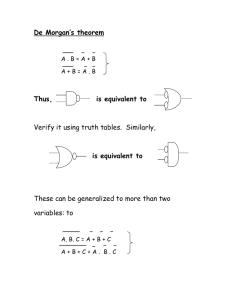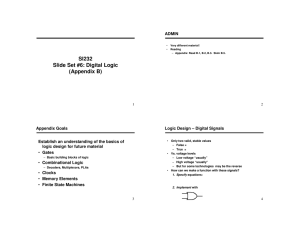
LABORATORY MANUAL Digital Systems and Logic Design Laboratory Department of Instrumentation Engineering JORHAT ENGINEERING COLLEGE Assam-785007 Do’s Ø Ø Ø Ø Ø Ø Ø Ø Ø Ø Ø Be punctual. Maintain discipline & silence. Keep the Laboratory clean and tidy. Enter Laboratory with shoes. Handle instruments with utmost care. Come prepared with circuit diagrams, writing materials and calculator. Follow the procedure that has been instructed. Return all the issued equipments properly. Get the signature on experiment result sheet daily. For any clarification contact faculty/staff in charge only. Shut down the power supply after the experiment. Don’ts Ø Avoid unnecessary chat or walk. Ø Playing mischief in the laboratory is forbidden. Ø Disfiguring of furniture is prohibited. Ø Do not start the experiment without instructions. Ø Avoid using cell phones unless absolutely necessary. Avoid late submission of laboratory reports. IN406 Experi ment No. 1 2 3 DSLD LABORATORY Title of the Experiment To study and verify the truth table of logic gates Realization of a Boolean function Design and implementation using NAND gate 4 Adders and Subtractors 5 Binary to grey generator 6 Multiplexer and Demultiplexer 7 8 Realization of a Boolean function using Logisim FlipFlop Semester IV L-T-P 0-0-2 1 CREDIT Objective of the Experiment Identify various ICs and their specification a. OR gate b. AND gate c. NAND gate d. NOR gate To simplify the given expression and to realize it using Basic gates and Universal gate To realize why NAND gate is known as the universal gate by implementation of : a. NOT using NAND b. AND using NAND c. OR using NAND d. XOR using NAND To realize a. Half Adder and Full Adder b. Half Subtractor and Full Subtractor by using Basic gates and NAND gates To learn the importance of weighted and non weighted code To learn to generate gray code . a. To design and set up a 4:1 Multiplexer (MUX) using only NAND gates. b. To design and set up a 1:4 Demultiplexer(DE-MUX) using only NAND gates. To learn the use of Logisim software to design digital electronics circuits. a. Truth Table verification of 1) RS Flip Flop 2) T type Flip Flop. 3) D type Flip Flop. 4) JK Flip Flop. b. Conversion of one type of Flip flop to another Text book: Ø Ø Ø Ø Modern Digital Electronics - R P Jain Digital Electronics: An Introduction To Theory And Practice by William Gothmann H Digital Electronics by John Morris Fundamentals of Digital Circuits by Anand Kumar Student Profile Name Roll Number Department Year Student Performance Sl. No. 1 Title of the Experiment To study and verify the truth table of logic gates 2 3 Realization of a Boolean function Design and implementation using NAND gate Adders and Subtractors Binary to grey generator Multiplexer and Demultiplexer Realization of a Boolean function using Logisim FlipFlop 4 5 6 7 8 Office Use Checked and found ………………………………………………… Grade/ Marks ………………………………………………… Signature …………………………………………………… Remarks EXPERIMENT: 1 LOGIC GATES AIM: To study and verify the truth table of logic gates OBJECTIVE: Identify various ICs and their specification a. b. c. d. OR gate AND gate NAND gate NOR gate COMPONENTS REQUIRED: • • • Breadboard. Connecting wires. IC 7400, IC 7408, IC 7432, IC 7406, IC 7402, IC 7404, IC 7486 THEORY: The basic logic gates are the building blocks of more complex logic circuits. These logic gates perform the basic Boolean functions, such as AND, OR, NAND, NOR, Inversion, Exclusive-OR, Exclusive-NOR. Fig. below shows the circuit symbol, Boolean function, and truth. It is seen from the Fig that each gate has one or two binary inputs, A and B, and one binary output, C. The small circle on the output of the circuit symbols designates the logic complement. The AND, OR, NAND, and NOR gates can be extended to have more than two inputs. A gate can be extended to have multiple inputs if the binary operation it represents is commutative and associative. These basic logic gates are implemented as small-scale integrated circuits (SSICs) or as part of more complex medium scale (MSI) or very large-scale (VLSI) integrated circuits. Digital IC gates are classified not only by their logic operation, but also the specific logiccircuit family to which they belong. Each logic family has its own basic electronic circuit upon which more complex digital circuits and functions are developed. The following logic families are the most frequently used. TTL Transistor-transistor logic ECL Emitter-coupled logic MOS Metal-oxide semiconductor CMOS Complementary metal-oxide semiconductor TTL and ECL are based upon bipolar transistors. TTL has a popularity among logic families. ECL is used only in systems requiring high-speed operation. MOS and CMOS, are based on field effect transistors. They are widely used in large scale integrated circuits because of their high component density and relatively low power consumption. CMOS logic consumes far less power than MOS logic. There are various commercial integrated circuit chips available. TTL ICs are usually distinguished by numerical designation as the 5400 and 7400 series. PROCEDURE: 1. 2. 3. 4. Check the components for their working. Insert the appropriate IC into the IC base. Make connections as shown in the circuit diagram. Provide the input data via the input switches and observe the output on output LEDs QUESTIONS: 1. Why NAND & NOR gates are called universal gates? 2. Realize the EX – OR gates using minimum number of NAND gates. 3. Give the truth table for EX-NOR and realize using NAND gates? 4. What are the logic low and High levels of TTL IC’s and CMOS IC’s? 5. Compare TTL logic family with CMOS family? 6. Which logic family is fastest and which has low power dissipation? EXPERIMENT: 2 REALIZATION OF A BOOLEAN FUNCTION. AIM: To simplify the given expression and to realize it using Basic gates and Universal gates LEARNING OBJECTIVE: § § To simplify the Boolean expression and to build the logic circuit. Given a Truth table to derive the Boolean expressions and build the logic circuit to realize it. COMPONENTS REQUIRED: IC 7400, IC 7408, IC 7432, IC 7406, IC 7402, Connecting wires, Bread board. THEORY: Canonical Forms (Normal Forms): Any Boolean function can be written in disjunctivenormal form (sum of min-terms) or conjunctive normal form (product of maxterms). A Boolean function can be represented by a Karnaugh map in which each cell corresponds to a minterm. The cells are arranged in such a way that any two immediately adjacent cells correspond to two minterms of distance 1. There is more than one way to construct a map with this property. Realization using NOR gates PROCEDURE: Check the components for their working. Insert the appropriate IC into the IC base. Make connections as shown in the circuit diagram. Provide the input data via the input switches and observe the output on output LEDs Verify the Truth Table RESULT: Simplified and verified the Boolean function using basic gates and universal gates QUESTIONS: 1) 2) 3) 4) 5) 6) 7) What are the different methods to obtain minimal expression? Realize I(A,B,C,D) =∑(0,1,2,3,4,5,6,7,8,9,10) and show the truthtables. What is a Min term and Max term State the difference between SOP and POS. What is meant by canonical representation? What is K-map? Why is it used? What are universal gates? EXPERIMENT: 3 DESIGN AND IMPLEMENTATION USING NAND GATE AIM: To design and implementation using NAND gate OBJECTIVE: § a. b. c. d. To realize why NAND gate is known as the universal gate by implementation of : NOT using NAND AND using NAND OR using NAND XOR using NAND COMPONENTS REQUIRED: • • • Breadboard. Connecting wires. IC 7400, IC 7408, IC 7432, IC 7406, IC 7402, IC 7404, IC 7486 THEORY: Boolean algebra is a branch of mathematical logic, where the variables are either true (1) or false (0).In order to construct NOT, AND, OR, XOR gates from NAND gates only, we need to be familiar with the following boolean algebra laws: 1. Involution Law 2. Idempotency (Idempotent) law 3. DeMorgan's Law 2 input XOR gate PROCEDURE: Check the components for their working. Insert the appropriate IC into the breadboard. Make connections as shown in the circuit diagram. Provide the input data via the input switches and observe the output on output LEDs Verify the Truth Table RESULT: NOT, AND, OR, XOR gate is realized using NAND gate. EXPERIMENT:4 ADDERS AND SUBTRACTORS ii) To Realize the Full subtractor using NAND Gates only PROCEDURE: • Check the components for their working. • Insert the appropriate IC into the IC base. • Make connections as shown in the circuit diagram. • Verify the Truth Table and observe the outputs. RESULT: QUESTIONS: 1) What is a half adder? 2) What is a full adder? 3) What are the applications of adders? 4) What is a half subtractor? 5) What is a full subtractor? 6) What are the applications of subtractors? 7) Obtain the minimal expression for above circuits. 8) Realize a full adder using two half adders 9) Realize a full subtractors using two half subtractors EXPERIMENT: 5 BINARY TO GREY CONVERTER AIM: To realize Binary to Gray code converter and vice versa. LEARNING OBJECTIVE: To learn the importance of non-weightedcode To learn to generate gray code COMPONENTS REQUIRED: IC 7400, IC 7486, and IC 7408, Patch Cords & IC Trainer Kit . RESULT: QUESTIONS: 1) What are code converters? 2) What is the necessity of code conversions? 3) What is gray code? 4) Realize the Boolean expressions for a) Binary to gray code conversion b) Gray to binary code conversion EXPERIMENT: 6 MULTIPLEXER AND DEMULTIPLEXER AIM: To design and set up the following circuit 1) To design and set up a 4:1 Multiplexer (MUX) using only NAND gates. 2) To design and set up a 1:4 Demultiplexer(DE-MUX) using only NAND gates. LEARNING OBJECTIVE: 3) 1. To learn about various applications of multiplexer and de-multiplexer PROCEDURE: • Check all the components for their working. • Insert the appropriate IC into the IC base. • Make connections as shown in the circuit diagram. • Verify the Truth Table and observe the outputs. VIVA QUESTIONS: 1) What is a multiplexer? 2) What is a de-multiplexer? 3) What are the applications of multiplexer and de-multiplexer? 4) Derive the Boolean expression for multiplexer and de-multiplexer. 5) How do you realize a given function using multiplexer 6) What is the difference between multiplexer &demultiplexer? 7) In 2n to 1 multiplexer how many selection lines are there? 8) How to get higher order multiplexers? 9) Implement an 8:1 mux using 4:1 muxes? EXPERIMENT: 7: REALIZATION OF A BOOLEAN FUNCTION USING LOGISIM AIM: To set up a circuit using Logisim: I(A,B,C,D) =∑(0,1,2,3,4,5,6,7,8,9,10) and show the truthtables. OBJECTIVE: 1.To learn about various applications of Logisim COMPONENTSREQUIRED: Logisim Software THEORY: The basic logic gates are the building blocks of more complex logic circuits. These logic gates perform the basic Boolean functions, such as AND, OR, NAND, NOR, Inversion, ExclusiveOR, Exclusive-NOR. All the combinational circuits are designed using these gates. PROCEDURE: § § § Solve the Boolean algebra expression using K Map Using different components draw the circuit in Logisim Simulate the circuit to verify RESULT: The simulation obtained from the circuit can be verified from the truth tables. • Attach the copy of the circuit designed in Logisim. EXPERIMENT: 8 FLIP FLOPS AIM: Truth Table verification of 1) RS Flip Flop 2) T type Flip Flop. 3) D type Flip Flop. 4) JK Flip Flop. OBJECTIVE: • To learn about various Flip-Flops • To learn about applications of FFs • Conversion of one type of Flip flop to another



